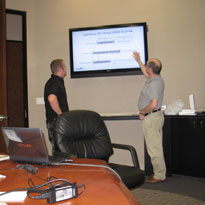Microwave & Fixed LOS Link Design
- Course:Microwave & Fixed LOS Link Design
- Course ID:MICROWAVE2 Duration:2 days Where: Your Office (7+ Persons)
- Download Course Description (PDF)
Available as a private, customized course for your group at your offices or ours and in some cases as a WebLive(TM) class.
Course Outline
- Introduction
- Microwave versus copper cable, fiber optics, and leased services
- Microwave frequency bands and regulations
- Channelizing the radio spectrum: Frequency, time, and code division multiple access (FDMA, TDMA, CDMA)
- History of analog microwave radio: FDM techniques and hierarchies; L Carrier and ITU frequency plans
- Digital Transmission Systems
- Sampling theory
- Time Division Multiplex (TDM) techniques and hierarchies
- North American and ITU digital hierarchies
- Plesiochronous Digital Hierarchy (PDH)
- Synchronous networks (SDH/SONET)
- Digital Power Spectra and Bandwidths
- Bandwidth definitions and requirements
- Nyquist and other shaping
- Regulatory masks
- Baseband data signals
- Filtering and rolloff factors
- Digital Modulation
- Amplitude, frequency, and phase shift keying (ASK, FSK, PSK)
- Binary versus M-ary modulation
- QPSK, Offset QPSK, and
 /4 QPSK
/4 QPSK - Minimum Shift Keying (MSK)
- QAM and Trellis Coded Modulation (TCM)
- Orthogonal FDM (OFDM)
- Line of Sight Transmission
- Free space loss
- Effect of terrain
- Reflection and diffraction
- Fresnel zones and path profiles
- Clearance requirements
- Effects of Climate
- Refraction and variations in radio refractivity (N factor)
- Snell’s law and the effective earth radius (K factor)
- Rain attenuation; specific rain rate and effective path length; ITU rain attenuation model
- Other atmospheric attenuation
- Prediction of outage using computer models
- Fading
- Multipath fading
- Reflection and diffraction causes
- Rayleigh, Rician, and log-normal statistics of fading
- Multipath propagation models; Barnett-Vigants observations; ITU models
- Diurnal and seasonal variations
- Effect of Fading on Digital Radio
- Flat versus frequency selective fading
- Minimum versus non-minimum phase fading
- M and W curves
- Flat, dispersive, and composite fade margins
- Calculation of estimated outage using computer models
- Equalization
- Linear versus non-linear equalization
- Transversal filter
- Zero-forcing equalization versus minimum mean-square error
- Decision feedback equalization and training equalizer
- Antennas and Diversity
- Antennas types and parameters: Gain, directivity, radiation pattern, polarization, beamwidth
- Waveguide types and characteristics: Rectangular, circular
- Diversity types: Space, frequency, angle, polarization, hybrid
- Diversity combining and improvements over non-diversity systems
- Forward Error Correction
- Definition of coding types and coding gain
- Types of block codes with examples: CRC and Hamming codes
- Convolutional coding and Viterbi decoding, with example
- Interleaving and turbo codes
- Radio Frequency Interference (RFI) Coordination
- Interference analysis for co-channel and adjacent-channel
- Carrier-to-Interference (C/I) ratio
- Threshold-to-interference (T/I) ratio
- Manual and computer-aided design for intra- and inter-system interference
- Frequency planning
- Satellite and other external interference
- Detailed analysis of a terrestrial RFI case
- Microwave Implementation
- Performance objectives
- Acceptance testing and performance monitoring
- Path engineering
- Wrap-up: Course Recap, Q/A, and Evaluations
Course in a Nutshell
Microwave links — fixed line-of-sight in particular – present some unique problems in areas such as propagation and fading characteristics. Mobility not being an issue, the relationship of the wave-length to the lengths of man made or natural obstacles becomes the principal concern in such environments.
This course will help you understand the (often non-intuitive) effects various obstacles in the transmitter-receiver path have on the received signal. You will learn how even those structures that are not in the direct path but merely close to it can have nontrivial effect on the signal. Upon completion of this course, you will be able to evaluate fixed links, determine the correct positions for the transmitting and receiving antennas, and identify the mitigating mechanisms for those occasions when the antennas cannot be optimally located.
Customize It!
Customize this course to your specific requirements at little-to-no additional cost. We offer distinct versions tailored for audiences such as:
- Network design and optimization engineers
- Equipment or application designers
- Less technical audiences such as managers, executives, business planners, sales and marketing specialists, and operations and support personnel.
Aimed At
The standard presentation of this course assumes a bachelor of science in Electrical Engineering, Mathematics, Physics, or a related subject along with some background in communications engineering.
Prerequisites
- At least one year experience in the field of communication engineering, fixed or wireless telephony, or related fields.

